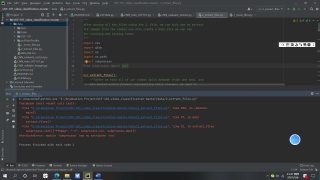
出现这个问题怎么解决?网上找找不到。
module 'subprocess' has no attribute 'src'

出现这个问题怎么解决?网上找找不到。
module 'subprocess' has no attribute 'src'
 关注
关注我在本地跑了下2_extract_files.py,我的系统也是windows
昨天我已经回答了你的1_move_files.py问题,如果你操作成功了,直接把我下面的代码复制过去替换掉原始代码(2_extract_files.py)就能直接跑起来了
首先提醒下,别忘记安装ffmpeg这个python包,我用的是Anaconda,直接一条指令就可以安装
conda install ffmpeg
先上代码:
"""
After moving all the files using the 1_ file, we run this one to extract
the images from the videos and also create a data file we can use
for training and testing later.
"""
import csv
import glob
import os
import os.path
from subprocess import call
def extract_files():
"""After we have all of our videos split between train and test, and
all nested within folders representing their classes, we need to
make a data file that we can reference when training our RNN(s).
This will let us keep track of image sequences and other parts
of the training process.
We'll first need to extract images from each of the videos. We'll
need to record the following data in the file:
[train|test], class, filename, nb frames
Extracting can be done with ffmpeg:
`ffmpeg -i video.mpg image-%04d.jpg`
"""
data_file = []
folders = ['./train/', './test/']
for folder in folders:
class_folders = glob.glob(folder + '*')
for vid_class in class_folders:
class_files = glob.glob(vid_class + '/*.avi')
for video_path in class_files:
# Get the parts of the file.
video_parts = get_video_parts(video_path)
train_or_test, classname, filename_no_ext, filename = video_parts
# Only extract if we haven't done it yet. Otherwise, just get
# the info.
if not check_already_extracted(video_parts):
# Now extract it.
src = train_or_test + '/' + classname + '/' + \
filename
dest = train_or_test + '/' + classname + '/' + \
filename_no_ext + '-%04d.jpg'
call(["ffmpeg", "-i", src, dest])
# Now get how many frames it is.
nb_frames = get_nb_frames_for_video(video_parts)
data_file.append([train_or_test, classname, filename_no_ext, nb_frames])
print("Generated %d frames for %s" % (nb_frames, filename_no_ext))
with open('data_file.csv', 'w') as fout:
writer = csv.writer(fout)
writer.writerows(data_file)
print("Extracted and wrote %d video files." % (len(data_file)))
def get_nb_frames_for_video(video_parts):
"""Given video parts of an (assumed) already extracted video, return
the number of frames that were extracted."""
train_or_test, classname, filename_no_ext, _ = video_parts
generated_files = glob.glob(train_or_test + '/' + classname + '/' +
filename_no_ext + '*.jpg')
return len(generated_files)
def get_video_parts(video_path):
"""Given a full path to a video, return its parts."""
print(video_path, type(video_path))
parts = video_path.split('\\')
parts.append(parts[0].split('/'))
print(parts)
filename = parts[2]
filename_no_ext = filename.split('.')[0]
classname = parts[1]
train_or_test = parts[3][1]
return train_or_test, classname, filename_no_ext, filename
def check_already_extracted(video_parts):
"""Check to see if we created the -0001 frame of this file."""
train_or_test, classname, filename_no_ext, _ = video_parts
return bool(os.path.exists(train_or_test + '/' + classname +
'/' + filename_no_ext + '-0001.jpg'))
def main():
"""
Extract images from videos and build a new file that we
can use as our data input file. It can have format:
[train|test], class, filename, nb frames
"""
extract_files()
if __name__ == '__main__':
main()
下面我说下我修改的地方,如下图所示,其实如果你是在Linux上跑这个代码,完全不需要更改,windows再次表示悲哀,斜杆与反斜杠。。。太坑

下面是我跑起来的截图,不过需要一段时间,毕竟是把视频切成一帧帧图片
